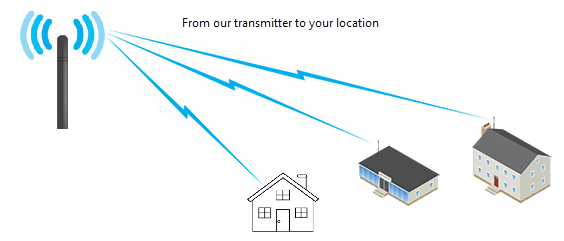Telecoms
Fixed wireless access broadband to hit 160m by 2025 – Report
Published
6 years agoon

Mobile broadband to account for 72% same year
Mobile data traffic in Sub-Saharan Africa to grow 12 times
__________________________________________________
By the end of 2025, fixed wireless access (FWA) connections are forecast to reach nearly 160 million, according to the latest Ericson’s Mobility Report released recently.
Read Also:
This will then push up FWA to represent about 25 per cent of global mobile network data traffic, whereas, at the end of 2019, global FWA data traffic was estimated to have been around 15 per cent of the global total.
The report found that around half of all households in the world which is more than one billion household lack a fixed broadband connection.
“Given the current speed and capacity of cellular networks with LTE, there are opportunities for African service providers to deliver broadband services to homes and small and medium-sized enterprises economically using FWA,” the report noted.
FWA delivered over 4G or 5G is a cost-efficient alternative to providing broadband in areas with limited access to fixed broadband services such as DSL, cable or fiber.
It is noted that several factors are driving the FWA market in Africa and beyond, which include demand from consumers and businesses for digital services along with government-sponsored programs and subsidies.
Consequently, it is now projected to grow nearly eight fold to reach 53 exabytes in 2025, representing 25 per cent of the global total mobile network data traffic.
The report also includes forecasts on data traffic growth, regional subscriptions plus insights into cloud-based gaming as well as in-depth articles on private dedicated networks and Verizon’s millimeter wave strategy for targeted metropolitan areas.
The report also foresee that mobile data traffic in Sub-Saharan Africa is estimated to grow by 12 times the current figures, with total traffic increasing from 0.33 Exabytes (EB) per month to 4EB by 2025.
Meanwhile, average traffic per smartphone is expected to reach 7.1GB over the forecast period.
In Sub-Saharan Africa, LTE accounted for around 11 per cent of subscriptions in 2019. Over the forecast period however, mobile broadband subscriptions are predicted to increase, reaching 72 per cent of mobile subscriptions.
LTE share will reach around 30 per cent by the end of the forecast period, and LTE subscriptions are set to triple, increasing from 90 million in 2019 to 270 million in 2025.
Fadi Pharaon, the president of ericsson middle east and Africa, said technology brings an unprecedented opportunity to address the challenges of sustainable economic development and improve the livelihood of people in Africa.
”The latest edition of Ericsson’s Mobility Report highlights Africa as one of the fastest growing mobile markets and reiterates the need for a more efficient technology, higher data rates and availability of ample spectrum.
”The Report highlights as well the importance of mobile and fixed networks as key components of critical national infrastructure to sustain and evolve emerging economies during remote work times,” he said.
He further added that driving factors behind the growth of mobile broadband subscriptions include a young and growing population with increasing digital skills, and more affordable smartphones.
Over the forecast period, discernible volumes of 5G subscriptions are expected from 2022, reaching 3 per cent by 2025.
Speaking to the value of digital infrastructure, Ericson noted that the spread of COVID-19 during the first part of 2020 impacted all parts of society globally, including the telecommunications sector.
“The Ericsson Mobility Report takes an incisive look at the role of networks and digital infrastructure in keeping societies running in Africa, and families connected during the COVID-19 pandemic,” the 36-paged report notes.
It said the pandemic has had a substantial impact on people in many countries and their daily lives, but consumers see resilient networks as a vital help in coping with everyday life.
In a recent study conducted by Ericsson Consumer Lab, it was found that 83 per cent of the respondents from 11 countries around the world claim that ICT helped them a lot to cope with the lockdown.
The results show an increased adoption and usage of ICT services, such as e-learning and wellness apps, that have helped consumers adapt to new realities, underpinned by connectivity, according to Ericson findings.
Share this:
- Click to share on X (Opens in new window) X
- Click to share on Facebook (Opens in new window) Facebook
- Click to share on WhatsApp (Opens in new window) WhatsApp
- Click to share on Pocket (Opens in new window) Pocket
- Click to share on Telegram (Opens in new window) Telegram
- Click to email a link to a friend (Opens in new window) Email
- Click to share on LinkedIn (Opens in new window) LinkedIn
